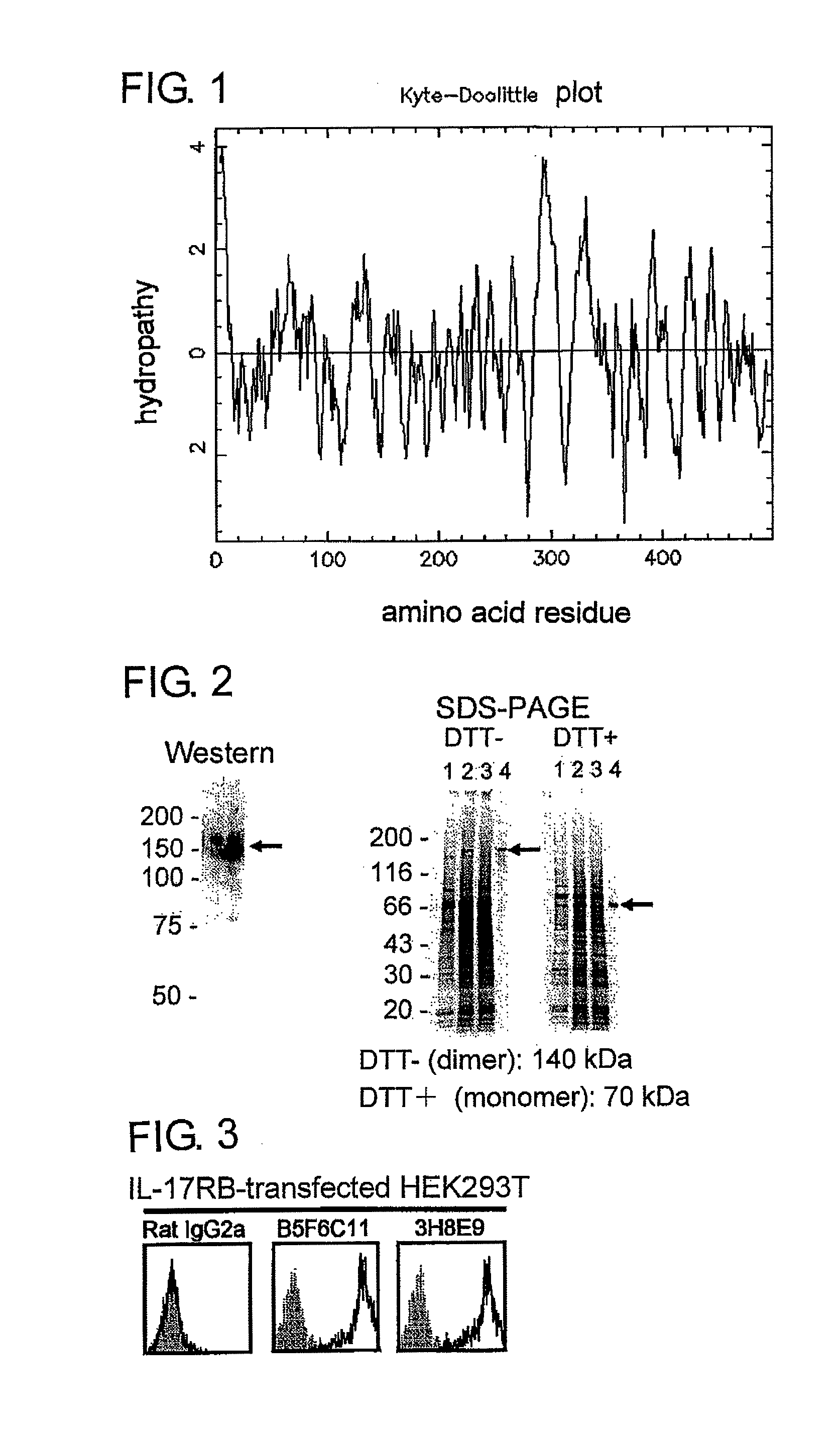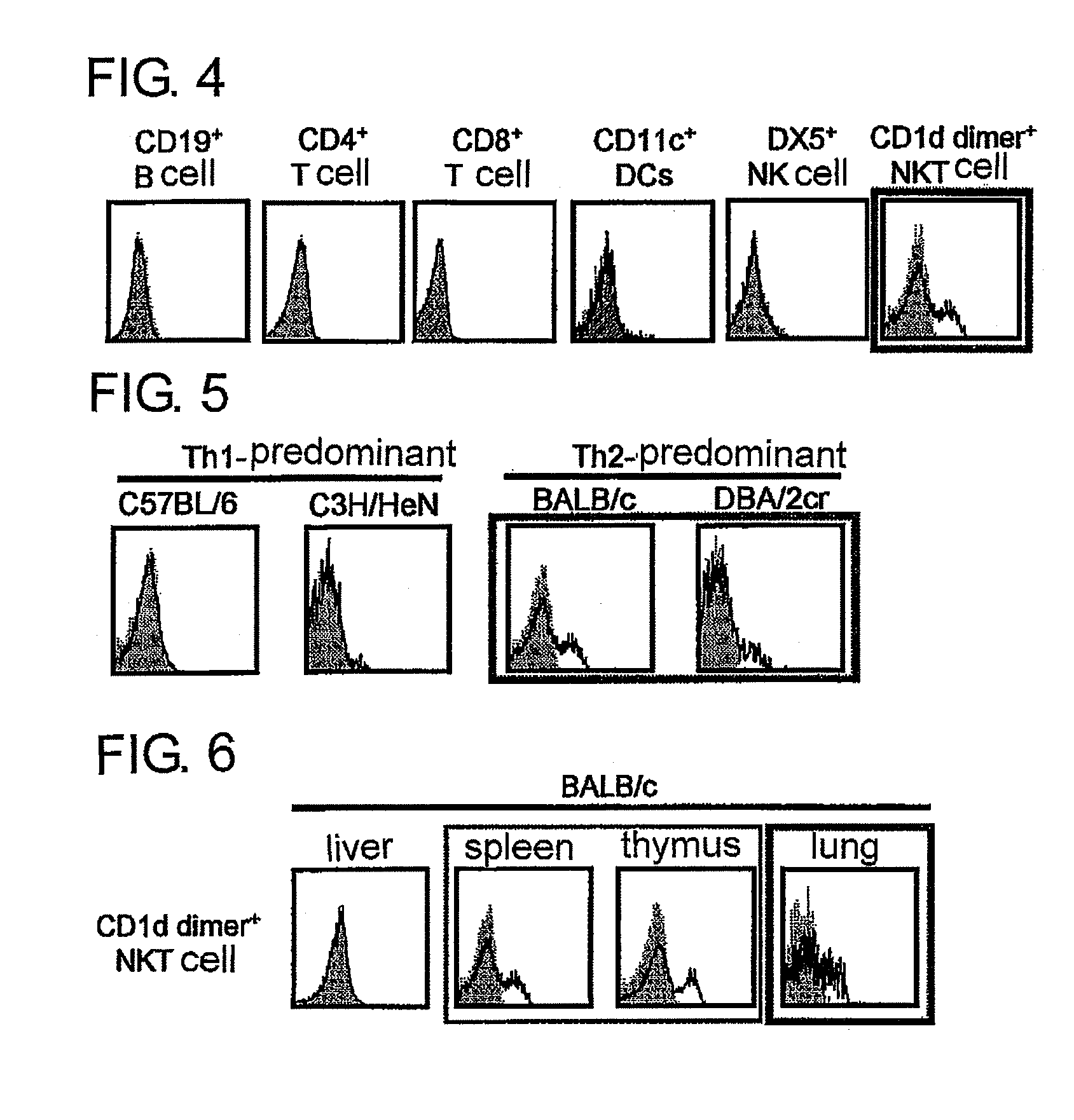Methods for treating allergic airway inflammation, airway hypersensitivity, and eosinophilia
a technology for allergic airway inflammation and eosinophilia, which is applied in the direction of fused cells, drug compositions, immunological disorders, etc., to achieve the effect of reducing the risk of allergic airway inflammation
- Summary
- Abstract
- Description
- Claims
- Application Information
AI Technical Summary
Benefits of technology
Problems solved by technology
Method used
Image
Examples
example 1
Identification of IL-17RB
[0102]A gene predominantly expressed in an NKT cell was extracted, using the results of a DNA microarray of various immunocytes reported by RIKEN RCAI (Bioinformatics, in press, 2007) as reference database. As a result, it was revealed that IL-17RB (NM—019583, 1420789_at) has a higher gene expression level than other immunocytes in the NKT cell. A presumed open reading frame structure of IL-17RB is shown in SEQ ID No.: 1, and a presumed amino acid sequence is shown in SEQ ID No.: 2.
[0103]A primary structure of a presumed amino acid sequence of the present membrane molecule was subjected to hydropathy plot analysis according to the method of Kyte and Doolittle (J. Exp. Med., vol. 157, pp. 105-132, 1982) (FIG. 1). As a result, it was revealed that IL-17RB is an I-type transmembrane protein having a signal sequence at an N end. IL-17RB consists of 499 amino acid residues and, from the results of hydropathy plot analysis, it is presumed that IL-17RB has a signal...
example 2
Preparation of a Soluble Recombinant of IL-17RB (Soluble IL-17RB-Ig)
[0104]From the result of hydropathy plot analysis (FIG. 1), a recombinant in which a region thought to be an extracellular domain and an Fc region of human IgG1 are bound was prepared. Note that, in order to prevent binding to an Fcγ receptor present on a surface of various cells, three positions of an Fc region of human IgG1 were subjected to amino acid replacement. Specifically, as the extracellular region, up to an amino acid position 282 of SEQ ID No.: 1 of IL-17RB was selected. A DNA sequence encoding this soluble recombinant is shown in SEQ ID No.: 3, and an amino acid sequence is shown in SEQ ID No.: 4. A site at which the amino acid replacement was performed in the Fc region corresponds to a position 302 (Leu→Ala), a position 303 (Leu→Glu) and a position 469 (Val→Asp). This gene was introduced into the pIRES2-EGFP vector (manufactured by Clontech), and this was transiently expressed in a 293T cell under cont...
example 3
Establishment of Specific Monoclonal Antibody to IL-17RB
[0105]The IL-17RB soluble recombinant described in Example 2 was immunized into a rat, and cell-fused with a rat myeloma cell strain P3U1 to obtain a specific monoclonal antibody-producing hybridoma. In screening, the recombinant described in Example 2 was solid-phased, a clone having reactivity was selected by an ELISA method and, at the same time, a specific monoclonal antibody was selected by analyzing reactivity to a 293T cell in which a full length of IL-17RB had been forcibly expressed, with a flow cytometer. The results of confirming reactivity between the culturing supernatant of the resulting monoclonal antibody-producing hybridoma (B5F6C11, 3H8E9) and the IL-17RB full length forcibly expressing strain are shown in FIG. 3.
PUM
| Property | Measurement | Unit |
|---|---|---|
| time | aaaaa | aaaaa |
| time | aaaaa | aaaaa |
| weight | aaaaa | aaaaa |
Abstract
Description
Claims
Application Information
 Login to View More
Login to View More - R&D
- Intellectual Property
- Life Sciences
- Materials
- Tech Scout
- Unparalleled Data Quality
- Higher Quality Content
- 60% Fewer Hallucinations
Browse by: Latest US Patents, China's latest patents, Technical Efficacy Thesaurus, Application Domain, Technology Topic, Popular Technical Reports.
© 2025 PatSnap. All rights reserved.Legal|Privacy policy|Modern Slavery Act Transparency Statement|Sitemap|About US| Contact US: help@patsnap.com



